Two deadly earthquakes have devastated Mexico’s southern coast and capital city, bringing Portland’s stark seismic reality a little closer to home.
The Pacific Northwest, aligned nicely above the Cascadian Subduction Zone, expects to see a magnitude 8—9 earthquake within the next 50 years. The implications are right under our nose: Mexico’s back-to-back magnitude 7.1 and 8.1 quakes killed hundreds of people and crumbled 39 buildings in Mexico City alone.
The impact on Portland, not to mention the Oregon and Washington coasts, Seattle, Eugene, and other dense cities, could be even greater.
So what is Portland State doing about it? The Vanguard spoke with Assistant Director Emma Stocker of PSU’s Emergency Management Program to find out.
Emergency Management adapts to new challenges
Emergency Management coordinates with the Environmental Health and Safety Office, Campus Public Safety Officers, and even the Center for Student Health and Counseling to deal with problems beyond “normal operating procedures,” Stocker explained.
Stocker elaborated that separate departments may deal with “emergency” leaks, chemical spills, or communicable diseases on their own, but EM steps in when problems are “bigger and weirder than we’ve ever dealt with before.”
However, preparation for these unprecedented emergencies is not easy to come by. Portland State does not have practice in managing devastating natural events like hurricanes or tornadoes, but last year’s snow and ice storms helped move Stocker’s department a bit further in the planning process.
When the winter weather, declared a total State of Emergency by Oregon Governor Kate Brown, hit PSU, Stocker said facilities workers stayed overnight and had to work with dwindling supplies. EM worked with the registrar to get finals moved around so students and professors could finish the Fall 2016 quarter.
“We had multiple levels of sheltering we needed to be prepared for,” Stocker said. Adding that there are over 2000 students that live on campus, Stocker said different levels of emergency sheltering needs to be in place even if there is a gas leak and an entire residence hall needs to be evacuated.
As a result, Stocker said EM is working on a Mass Care and Sheltering Plan, based off Multnomah County’s, to house and feed employees and students that might find themselves stranded on campus or not have a local friend or family network.
Additionally, Stocker said PSU’s new contract with foodservice provider Chartwells has been an asset to EM. Because Chartwells operates in universities across the country, Stocker said PSU Eats’ Resident District Manager Jason Boss has been able to get sample emergency plans and experiences from “his national support teams and other food source vendors.”
At the moment, PSU Eats is able to supply campus with three days’ worth of full meals.
Earthquake-proofing campus
A comprehensive step-by-step earthquake plan does not seem to exist at PSU, but new construction projects and major renovations give PSU the opportunity to make safer physical spaces on campus.
Ten structures out of fifty PSU-owned buildings on campus have received seismic upgrades since 2002. Neuberger Hall, set to receive a major renovation over the next two years, is in need of a seismic upgrade, but no specific earthquake-ready renovation plans have been made public.
However, Stocker said getting money to make more seismic upgrades has been a challenge.
Business Oregon has offered a Seismic Rehabilitation Grant to K-12 schools, community colleges, state universities, and public service buildings since 2007. According to Stocker, the original language of the grant only made money available to buildings owned by Oregon University System, which dissolved in 2015. Since then, Stocker has not been able to find out how to acquire grant money for PSU. “I’ve been trying to get an answer on this for over a year at this point,” Stocker said.
Even with seismic upgrades, Stocker explained how buildings may not be usable after an earthquake. According to Stocker, current seismic codes only require buildings to offer “life safety.” This means that people would have a chance to evacuate from upgraded buildings, but not that those buildings would be safe to remain in.
Stocker added that EM is also developing a “damage assessment plan” this year to be prepared to scope out post-earthquake damage.
Helping individuals prepare
EM has been invited to present at individual departments across campus, but this year marks the first that EM and CPSO will host general information sessions on personal safety, earthquake safety, and active shooter scenarios. Currently emergency training is not mandated for students, but student housing staff have started receiving training this year as well.
Stocker said she hopes to see emergency training integrated into new student orientation. Until then, however, she realizes gaps exist on an individual basis: not just because students may not know about Portland’s earthquake risk, but because financially and space-strained students cannot make collecting gallons of water and nonperishable food a number one priority.
“That’s why [PSU] is working on having those supplies,” Stocker said.
To learn more about Portland’s impending megaquake, watch the documentary ‘Unprepared’ free on the Oregon Public Broadcasting website, where you can also access impact maps and preparation guides. EM’s first general emergency preparedness session will be on Nov. 7, 2017, at 2 p.m. in Smith Memorial Student Union Room 338.






